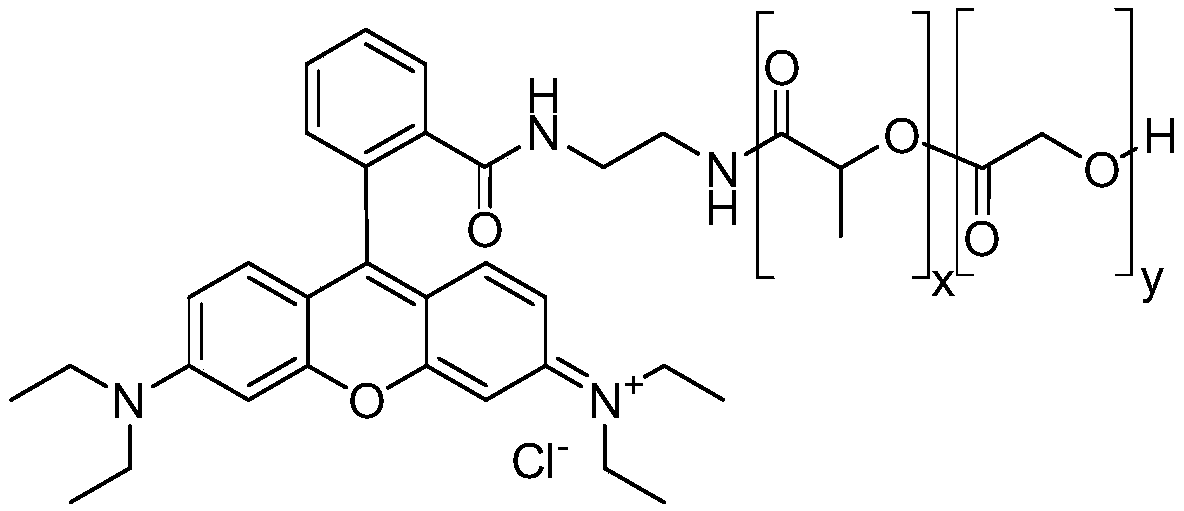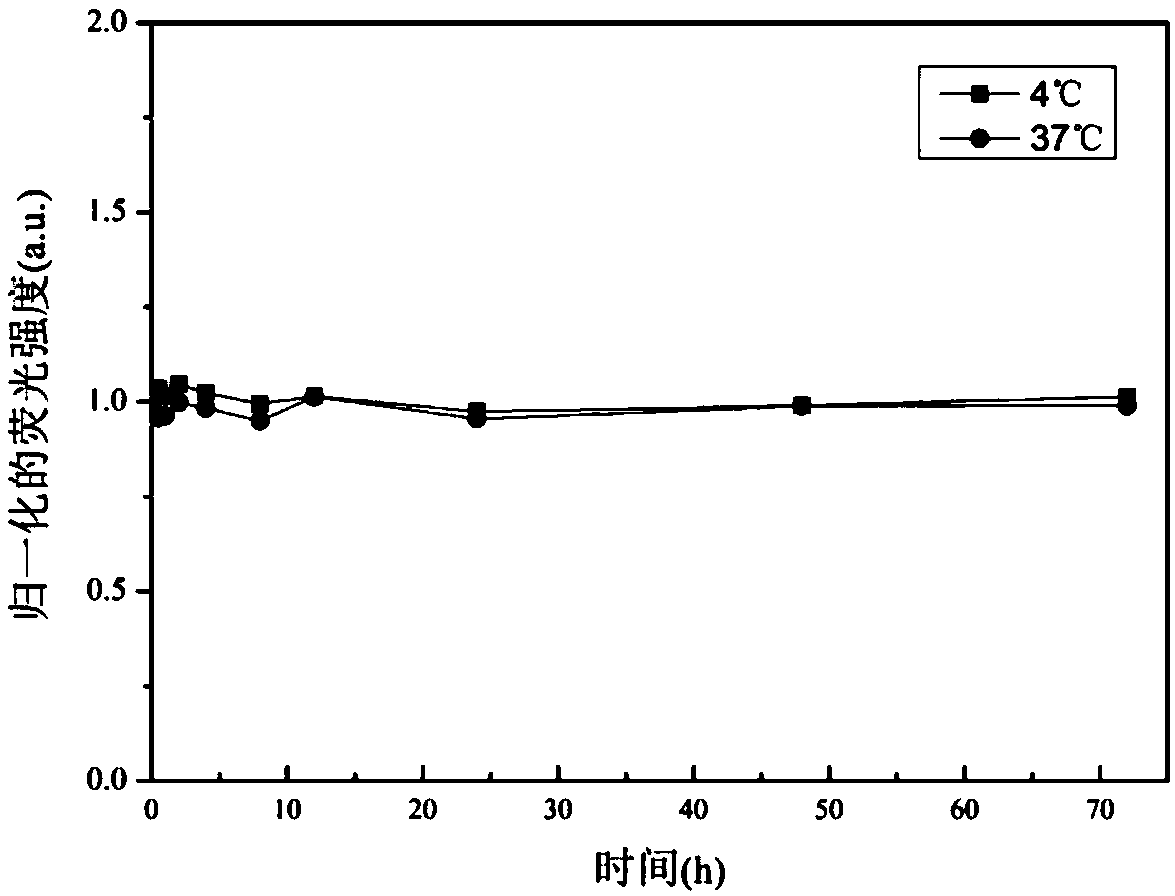Double-emitting fluorescent nanoparticle preparation method
A dual-emission fluorescence and nanoparticle technology, which is applied in the field of preparation of dual-emission fluorescence nanoparticles, achieves the effects of mild reaction conditions, good stability, and simple and easy-to-obtain raw materials
- Summary
- Abstract
- Description
- Claims
- Application Information
AI Technical Summary
Problems solved by technology
Method used
Image
Examples
Embodiment 1
[0041] Synthesis of the polylactic acid-glycolic acid copolymer material modified by embodiment 1 rhodamine B
[0042] Dissolve 150 mg of poly(lactic acid-glycolic acid) copolymer completely in 8 mL of dichloromethane, add 3.8 mg of N-hydroxysuccinimide, 110 μL of triethylamine and 6.2 mg of 1-ethyl-3 -(3-Dimethylaminopropyl)carbodiimide hydrochloride, gradually warming up to room temperature and reacting for 10 hours to obtain reaction solution A, add 5 μL ethylenediamine to 3.2mL dichloromethane solution, mix well, and then The dichloromethane solution of ethylenediamine was added dropwise to the reaction solution A, and reacted at room temperature for 20 hours. After the reaction was completed, the reaction system was washed successively with saturated aqueous sodium bicarbonate solution, distilled water and saturated aqueous sodium chloride solution, and then washed with anhydrous Sodium sulfate was dried overnight, filtered, and the filtrate was dried under reduced pressu...
Embodiment 2
[0044] Synthesis of the polylactic acid-glycolic acid copolymer material modified by embodiment 2 rhodamine B
[0045] Dissolve 200mg of poly(lactic acid-glycolic acid) copolymer completely in 10mL of dichloromethane, add 4.6mg of N-hydroxysuccinimide, 120μL of triethylamine and 7.8mg of 1-ethyl-3 -(3-Dimethylaminopropyl)carbodiimide hydrochloride, gradually warming up to room temperature and reacting for 12 hours, to obtain reaction solution A, add 6.7 μL ethylenediamine to 4mL dichloromethane solution, mix well, and then The dichloromethane solution of ethylenediamine was added dropwise to the reaction solution A, and reacted at room temperature for 23 hours. After the reaction was completed, the reaction system was washed successively with saturated aqueous sodium bicarbonate solution, distilled water and saturated aqueous sodium chloride solution, and then washed with anhydrous Sodium sulfate was dried overnight, filtered, and the filtrate was dried under reduced pressure ...
Embodiment 3
[0051] Example 3 Fluorescence Stability Investigation of Rhodamine B Modified Polylactic-Glycolic Acid Copolymer Material
[0052] In order to investigate whether the polylactic acid-glycolic acid copolymer modified by Rhodamine B can emit fluorescence, 5 mg of the polylactic acid-glycolic acid copolymer modified by Rhodamine B prepared in Example 2 was completely dissolved in dichloromethane to obtain a concentration of 0.5mg / mL rhodamine B-modified copolymer dichloromethane solution; take rhodamine B-modified polylactic acid-glycolic acid copolymer 0.4mL dichloromethane solution, add methanol to make a concentration of 4μg / mL rhodamine The methanol solution of the copolymer modified by B is detected by a fluorescence spectrophotometer, and the spectrogram is shown in figure 2 ; The rhodamine B modified polylactic acid-glycolic acid copolymer methanol solution was placed at 37°C and 4°C under natural light for a certain period of time to investigate the fluorescence stabilit...
PUM
| Property | Measurement | Unit |
|---|---|---|
| Volume average particle size | aaaaa | aaaaa |
Abstract
Description
Claims
Application Information
 Login to View More
Login to View More - R&D
- Intellectual Property
- Life Sciences
- Materials
- Tech Scout
- Unparalleled Data Quality
- Higher Quality Content
- 60% Fewer Hallucinations
Browse by: Latest US Patents, China's latest patents, Technical Efficacy Thesaurus, Application Domain, Technology Topic, Popular Technical Reports.
© 2025 PatSnap. All rights reserved.Legal|Privacy policy|Modern Slavery Act Transparency Statement|Sitemap|About US| Contact US: help@patsnap.com



